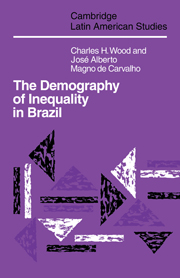Book contents
- Frontmatter
- Contents
- Illustrations
- List of tables
- Preface
- 1 Introduction
- 2 Framework for the study of population, development and inequality
- 3 Growth and distribution in historical perspective
- 4 Income inequality and length of life
- 5 Wage policy, infant mortality and collective social action in São Paulo
- 6 Racial inequality and child mortality
- 7 The “baby bust”
- 8 Income distribution and population growth
- 9 Agrarian structure and the rural exodus
- 10 Colonization and frontier expansion in Amazônia
- 11 Development and persistent underemployment
- 12 The demography of inequality in Brazil: summary and conclusion
- Appendix: A note on method
- Notes
- Bibliography
- Index
- CAMBRIDGE LATIN AMERICAN STUDIES
7 - The “baby bust”
Published online by Cambridge University Press: 04 August 2010
- Frontmatter
- Contents
- Illustrations
- List of tables
- Preface
- 1 Introduction
- 2 Framework for the study of population, development and inequality
- 3 Growth and distribution in historical perspective
- 4 Income inequality and length of life
- 5 Wage policy, infant mortality and collective social action in São Paulo
- 6 Racial inequality and child mortality
- 7 The “baby bust”
- 8 Income distribution and population growth
- 9 Agrarian structure and the rural exodus
- 10 Colonization and frontier expansion in Amazônia
- 11 Development and persistent underemployment
- 12 The demography of inequality in Brazil: summary and conclusion
- Appendix: A note on method
- Notes
- Bibliography
- Index
- CAMBRIDGE LATIN AMERICAN STUDIES
Summary
Available data indicate that fertility rates in Brazil remained fairly constant through the first half of this century. In the late 1960s, the birth rate then began a sudden and rapid decline. The pace of the transition from high to lower fertility was arguably the most significant demographic event in the country's recent history. The change was all the more remarkable because of the pattern of the fertility change by socioeconomic strata. The common expectation is for the onset of lower fertility to begin among the urban middle class, gradually spreading downward through the social ranks and outward to the countryside. Recent estimates for Brazil, in contrast, show a sharp and simultaneous drop in the birth rate among all social groups, both urban and rural.
In keeping with the perspective adopted in previous chapters, we reject the assumption that social change had equal consequences for all socioeconomic groups. Instead, our objective is to examine the manner in which recent transformations in Brazilian social and economic structure unequally affected different subclasses of the population, stimulating a reduced demand for children. If fertility fell in all socioeconomic strata, the point we wish to make is that this common outcome was caused by factors that were more or less specific to different sectors of the population. Comparing rural and urban areas, and middle and lower income groups, we find different macrostructural processes working to alter reproductive behavior in favor of a smaller family size.
- Type
- Chapter
- Information
- The Demography of Inequality in Brazil , pp. 154 - 183Publisher: Cambridge University PressPrint publication year: 1988



